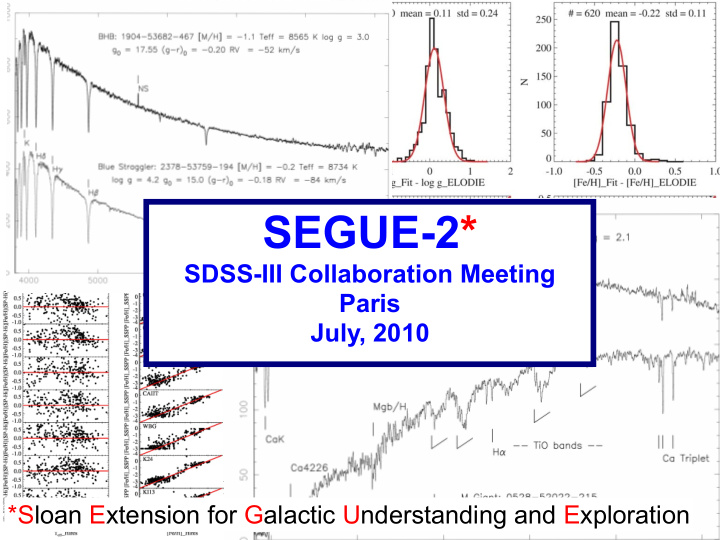



SEGUE-2* SDSS-III Collaboration Meeting Paris July, 2010 *Sloan Extension for Galactic Understanding and Exploration
Survey Description • Old Milky Way stellar populations, Galactic archaeology: see science talks this meeting • Use wide field, high throughput of the SDSS survey telescope, fiber spectrographs - moderate resolution - many lines of sight - in situ old thin and thick disk, halo stars • SEGUE-2 observations: all dark time 1st year of SDSS-III (shared w/ BOSS imaging) - will release with DR8, Jan 2011
Survey Data • R=1800 spectra, 3800Å - 9000Å • 7 sq. deg lines of sight - non-contiguous • targets selected from SDSS ugriz imaging, USNOB proper motions (Munn et al. 2004) - 14 < g < 20 - more distant than RAVE • Builds on the SEGUE-1 survey (Yanny et al. 2009) - done in parallel with finishing the original SDSS galaxy survey, part of DR7 - data from both survey processed, released and documented together for DR8
SEGUE -2 202 Lines of Sight 124,000 science spectra Observations complete Focus on faint/distant targets Improved selection of metal-poor stars, halo giants and BHBs based on SEGUE-1 experience
Spectroscopic Targets • in-situ tracers of substructure, mass profile in the outer halo: K-giants, BHBs, M-giants • all candidates get fibers: sample limitation is survey area • Galactocentric distances to 80 kpc • old stellar populations: low-metallicity, ultra- cool white dwarfs, high proper motion dwarfs, high velocity, old MS turnoff • one “deep” plate per line of sight
SEGUE-1 260,500 science spectra 157 field pointings 16 pointings on known substructure 11 “low latitutde” pointings 8º<|b|<20º ugriz imaging stripes : 3500 deg 2 @ |b|<35° and through the SEGUE @DR7, July 2008 Galactic plane http://www.sdss.org/dr7 Yanny et al. 2009
SEGUE-1 Targets • two plates per pointing, bright and faint • larger fraction of fibers given to targets selected in slices of g-r to spread fibers over the old MS warmer than 4000K • stars in the coolest slice are to d~ 2 kpc, w/ good USNOB +SDSS proper motion data • the MSTO UV- excess selection reaches 15-20 kpc
SEGUE Stellar Parameters Pipeline Multiple methods, valid in specific ranges of S/N, g-r Applied to all stellar data taken with SDSS spectrographs For 5000K<Teff<7500K , S/N > 10 / 1Å pix: σ (Teff) 157K σ ([Fe/H]) 0.29 σ (logg) 0.24 σ (RV) < 4 km/s for g <18 SSPP: Lee et al (2008) a,b Main DR8 improvements: robust Allende Prieto et al. 2008 combination of estimators, RVs from Schlegel/Loomis/ accuracy @ [Fe/H] > -0.5 Gunn spectro pipeline
Spectroscopic Calibration Sample SEGUE-1 + SEGUE-2 special calibration plates on cluster stars: M92 M13 M15 M2 NGC 2420 M67 M71 NGC 6791 Field stars: 100+ stars observed with SEGUE Be 29 and high resolution spectrographs on HET, Keck, VLT, Subaru, ... (Allende Prieto et al. 2008)
Globular Cluster Photometry and Fiducial Sequences M3 Before: outskirts only After: Full area, Calib. to field SDSS (carefully) An et al. 2008
Status • Observations, data processing complete - no substantive changes to the extraction, flux calibration, RV pipelines - new, improved version of the SSPP • Spectra, RVs, SSPP outputs available to the collaboration as fits binary tables • Spectra, RVs, SSPP outputs loaded into a “pre-DR8 CAS” sql database, available to the collaboration - matched to a copy of DR7 imaging data - improvements vs. DR8 to make queries easier - documentation is the next big task, including the SEGUE-2 paper
Recommend
More recommend